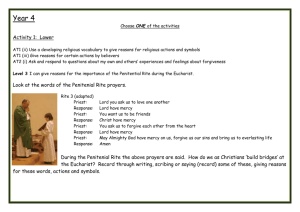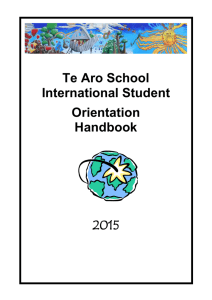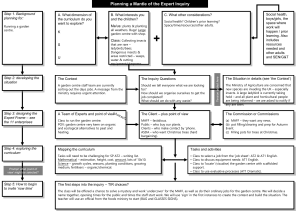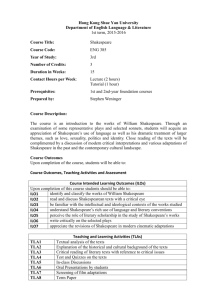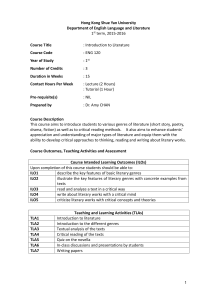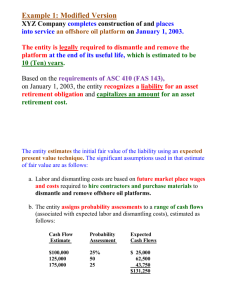Pentecost – Serving – Serving – Year 4
advertisement
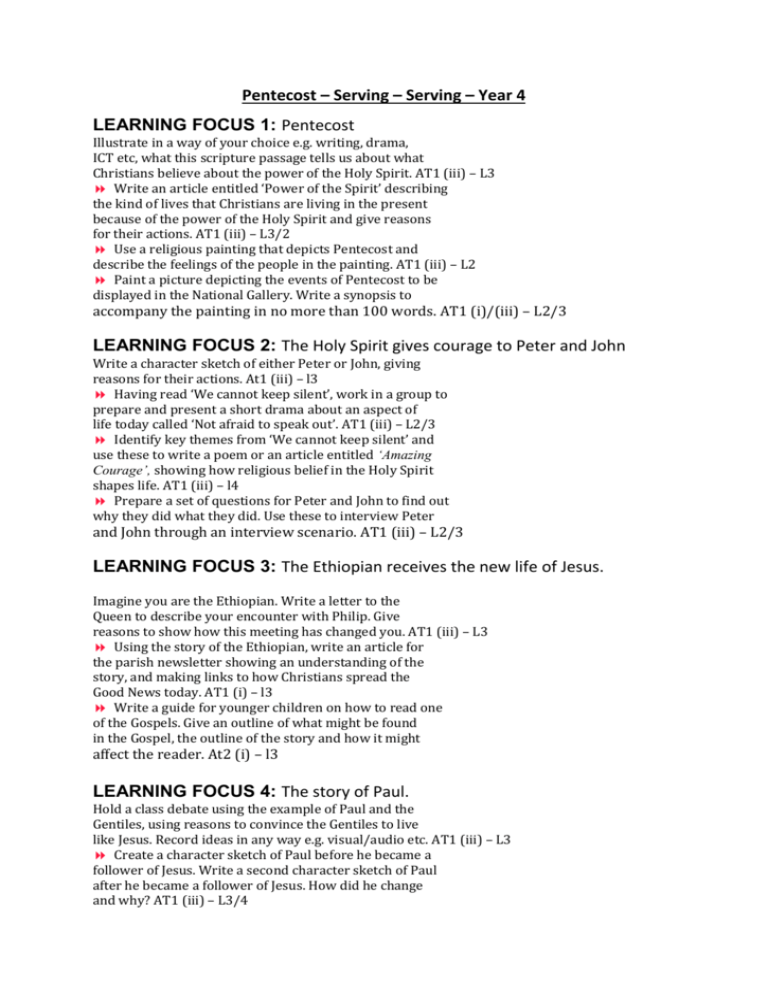
Pentecost – Serving – Serving – Year 4 LEARNING FOCUS 1: Pentecost Illustrate in a way of your choice e.g. writing, drama, ICT etc, what this scripture passage tells us about what Christians believe about the power of the Holy Spirit. AT1 (iii) – L3 Write an article entitled ‘Power of the Spirit’ describing the kind of lives that Christians are living in the present because of the power of the Holy Spirit and give reasons for their actions. AT1 (iii) – L3/2 Use a religious painting that depicts Pentecost and describe the feelings of the people in the painting. AT1 (iii) – L2 Paint a picture depicting the events of Pentecost to be displayed in the National Gallery. Write a synopsis to accompany the painting in no more than 100 words. AT1 (i)/(iii) – L2/3 LEARNING FOCUS 2: The Holy Spirit gives courage to Peter and John Write a character sketch of either Peter or John, giving reasons for their actions. At1 (iii) – l3 Having read ‘We cannot keep silent’, work in a group to prepare and present a short drama about an aspect of life today called ‘Not afraid to speak out’. AT1 (iii) – L2/3 Identify key themes from ‘We cannot keep silent’ and use these to write a poem or an article entitled ‘Amazing Courage’, showing how religious belief in the Holy Spirit shapes life. AT1 (iii) – l4 Prepare a set of questions for Peter and John to find out why they did what they did. Use these to interview Peter and John through an interview scenario. AT1 (iii) – L2/3 LEARNING FOCUS 3: The Ethiopian receives the new life of Jesus. Imagine you are the Ethiopian. Write a letter to the Queen to describe your encounter with Philip. Give reasons to show how this meeting has changed you. AT1 (iii) – L3 Using the story of the Ethiopian, write an article for the parish newsletter showing an understanding of the story, and making links to how Christians spread the Good News today. AT1 (i) – l3 Write a guide for younger children on how to read one of the Gospels. Give an outline of what might be found in the Gospel, the outline of the story and how it might affect the reader. At2 (i) – l3 LEARNING FOCUS 4: The story of Paul. Hold a class debate using the example of Paul and the Gentiles, using reasons to convince the Gentiles to live like Jesus. Record ideas in any way e.g. visual/audio etc. AT1 (iii) – L3 Create a character sketch of Paul before he became a follower of Jesus. Write a second character sketch of Paul after he became a follower of Jesus. How did he change and why? AT1 (iii) – L3/4 Transporting a character. Imagine you are Paul today and many people are turning out at the O2 Arena to listen to you. Your task is to help people to understand how the Holy Spirit is working today in the Church in the same way as we read in the Acts of the Apostles. AT2 (i) – L3/4 LEARNING FOCUS 5: Paul spreads the good news. Look in the Bible (references given above) and make a list of all the letters Paul wrote to people living in certain places. Using the map from the website match, up the names of the people with the names of the places for example Galatia – Galatians in Turkey.At1 (i) – L3/4 Write a diary extract, based on the events of Paul’s experiences on his journeys. Include a record of how you think he felt and why. AT1 (i) – L2,3,4. Set up a series of scenarios which reflect daily life e.g. falling out on the playground. Using the Gifts of the Holy Spirit e.g. love, joy and peace, patience, kindness, goodness, trust, gentleness, faithfulness and self-control, resolve the situation giving reasons for the gift you have chosen. AT2 (i) – L3/4 LEARNING FOCUS 6: The Holy Spirit gave Paul new life and happiness. Use some Widgit symbol-supported text to illustrate how Paul was feeling. AT1 (iii) - SEN Make a booklet about Paul. Make reference to his message, his journeys, his hardships, his advice and his beliefs. AT1 (iii) – L2.3.4 Ask the pupils to imagine that they are Paul. Invite them to prepare a talk/write a speech for the class. They are to include how he feels and what he believes and how this has helped him to stay strong. Hold a question time following the speech. AT1 (iii), AT2 (i) – L3 Thought for the Day is a short reflection broadcast every day on Radio 4. It is based on a religious issue, belief or question. You have been invited to speak on the programme for about 2 minutes and the title you have been given is – ‘A whole new way of living’. Write your script showing how belief in the Good News and the coming of the Holy Spirit at Pentecost shapes the lives of Christians today. AT1 (iii) – L4/3 Reconciliation – Inter-relating – Building Bridges – Year 4 LEARNING FOCUS 1: Everyone is loved by Jesus. Act out the story of The Lost Sheep. Include words that describe your feelings of being lost and found and why the good shepherd should go and look for the sheep. AT1 (i)/AT2 (i) 0 L2/3 Describe your image of God, represented here by the Good Shepherd and what that means for Christians. How might Christians live out their live in the light of this teaching? Give reasons for their actions. AT1 (iii) / AT2 (ii) – L2/3 With a partner, discuss why you think God would go in search of the ‘lost one’. AT2 (ii) – L2/3 Design a ‘map’ for a Christian who may be ‘lost’ – include on it ‘signposts’ of advice and ways to live their lives. AT1 (iii) – L2 LEARNING FOCUS 2: Sin and examination of conscience. Describe the ways in which God’s law of love can be broken – thinking, saying or doing anything that spoils or breaks friendship with God or with other people. It is also choosing not to do something which again results in breaking friendship with God and other people. Write a short story/account to illustrate one of these occasions. AT1 (iii) – L2 Think of a way you can build a bridge to reach out to someone you have hurt or offended today. Give reasons for the ways you choose. At1 (iii) – L3 Using a range of pictures, symbols, images and text, create a PowerPoint presentation entitled ‘Building Bridges’ which explores how we, as Christians, can build ‘bridges’ of friendship and goodness through our thoughts and actions. Links can also be made to relevant Scripture passages/quotations. AT1 (i) – L3 LEARNING FOCUS 3: The Sacrament of Reconciliation: contrition. Write out the different names for this sacrament and what they mean and give reasons why you think they are good names. AT1 (ii) – L3 With a talk-partner, think of ways in which being sorry might be expressed in our daily lives. Explore some of the ways you would explain this to a younger child, helping them to appreciate and have contrition. Explain how they might feel if they do that. AT1 (iii) – L2/3 Compile a glossary of words associated with the Sacrament of Reconciliation. Create three columns; one for the word, the second for its meaning and a third one called ‘in daily life’ where examples of the meaning of the word can be recorded; e.g. Reconciliation - bringing together - you can build bridges with someone when you forgive them or they forgive you. AT1 (ii) – L2/3 Take time to pause and reflect. Write your own prayer of sorrow to God. It will be called an Act of Contrition. AT1 (ii) – L2/3 LEARNING FOCUS 4: Penitential rite 1 and 2. In groups, choose some Scripture readings, prayers and songs/hymns, music and a picture that would be suitable for a class celebration of Reconciliation. Share the reason for the choice. AT1 (i) / (ii) – L3 Come together as a class to celebrate a simple liturgy of Reconciliation. Choose prayers etc. from the group work, light a candle and prepare the classroom. Finishing with an Act of Contrition and a hymn of thanksgiving. AT1 (ii) – L3 Add to your glossary. In pairs or small groups, discuss any additional words/phrases and their meaning. AT1 (ii) – l2/3 LEARNING FOCUS 5: Absolution. Write a suitable prayer for the priest and penitent to say together. AT1 (ii) – l2 Create a PowerPoint, illustrating God’s love and peace. With a talk-partner, discuss the kind of penance that might be helpful to someone who has received the Sacrament of Reconciliation. Explain your reasons and the possible effect it might have on the person. Share your findings. AT1 (iii) – L3 Reflect on some of the ways you wish to do better. Compose a prayer about this and the help/support you seek from the Holy Spirit. AT1 (ii) – L2/3 LEARNING FOCUS 6: Bridge building in the Christian community. Individually or in pairs, write about an occasion, real or imaginary, when each of Paul’s signs have been used. Give some reasons for the words spoken/actions taken. AT1 (iii) – L3 Write a story, imaginary or real, about a person who reaches out to another to ‘build a bridge’. Research the life of someone special (a saint or someone you know). AT1 9iii) – L2/3 Write a letter to a friend saying why you are friends and how you might continue this friendship in the future. Try to refer to/use some of the Scripture used within this topic. AT1 (i) – L3 Universal Church – World – God’s People – Year 4 LEARNING FOCUS 1: The Communion of Saints: showing people what God is like. Individually, with a partner or in a group, invite the children to research a saint: it might be a saint of their school, parish church, their name or the name of someone in their family. They could use the internet or books. (The Friends of Jesus series may be helpful). Share the findings with the class. Encourage the children to discover some of the ideas, beliefs, feelings and experiences particular to the saint of their choice. AT2 (i) – l3 Have key facts about the saints you have discussed in the lesson. The children match these key facts with the correct saint. AT1 (iii) – L2 Hot-seating activity – encourage the children to prepare some questions to ask “a saint” which will help them develop a deeper understanding of the beliefs/life of the saint. At2 (i) – L2/3 Invite children to take out their Book of Qualities or look at the collection of words from the Reflection on Significance in Explore. Can these qualities be matched to the profile of any of the saints they have learnt about? Ask the children to add further qualities. AT1 (iii) / AT2 (i) – L2/3 LEARNING FOCUS 2: Christians are invited to be saints. Invite the children to produce a mind map on paper or using mind mapping software – “What kind of person would I really like to be?” AT1 (iii) – L2/3 A question for the children to work with, “If you were the Pope, what messages would you give to children?” Prepare a speech to give to your class. In it make a link to one of Jesus’ stories or explain why it is important to follow God’s way. At1 (i) – L3 Create a class collage display, which can be added to as the topic progresses – “Living a saintly life” – include pictures, drawings, poems, prayers , recent events etc. AT1 (iii) – L2/3 LEARNING FOCUS 3: Oscar Romero – a recent martyr showing us what God is like. Ask the children to design a memorial for Oscar Romero. They may wish to include a quote from Oscar Romero, or a poem to sum up his life. Show them some examples of memorials and look at the murals in the PowerPoint presentation at cafod.org.uk/comeandsee. At1 (iii) – l2/3 Invite the children to work individually or in groups to answer two contrasting questions: • How and why is Oscar Romero remembered? • How would you like to be remembered? AT1 (iii) – L3 Hot-seating activity – one child plays the role of Oscar Romero. The children ask questions relating to why Romero behaved as he did, exploring his beliefs, decisions, ideas and experiences. AT1 (iii) – L3/4 LEARNING FOCUS 4: An ordinary person showing us what God is like. Using Colossians 3: 10-11 (God’s Story 3, page 147) design a phrase or motto to live by (or a brief mission statement) for us to use in our lives. Decorate and share these with our class/school. AT1 (i) – L3 Discuss with a partner or in a group the different gifts the other person or people have (for example, they may be good at maths; can play the recorder; listen to others; can offer good advice; can write interesting stories etc.) Create a mind map of ‘Our Gifts’. How does this show us a picture of what God is like? How can these gifts be used to help others in our school, our local area and our sisters and brothers around the world? AT2 (i) – L3 Invite the children to write a letter to a younger child in the school, telling them what they have been learning about saints and, in particular, how they can live their lives to show what God is like and why it would be good to do so. Invite the children to convey the gifts/qualities they have through a piece of writing, music, picture or dance/movement. At2 (i) – L3 LEARNING FOCUS 5: Blessed Teresa of Calcutta – living out what she believed. Hot-seating Blessed Teresa – one child plays the role of Blessed Teresa. The children ask questions about why she behaved as she did. AT1 (iii) – L2/3 Look at the CAFOD website to find out more information about the latest emergencies that CAFOD is supporting. Why is CAFOD involved in emergency work? Discuss how your school could help. Consider writing to your headteacher explaining why you think your class should support CAFOD’s emergency work, referring to Christian values, Paul’s advice and the example of Blessed Teresa. AT1 (iii) – L2/3 Create a series of scenarios which involve having to make a decision/choice. “Freeze frame” these so the children can provide suggestions for what to do next, in the light of what they have been learning. Give reasons for your decisions/actions. At2 9i) – L3 Look up God’s Story 3, page 148, and read the advice that Paul gives the Thessalonians about how to behave. Write an obituary (that is something written about a person after they have died) for Blessed Teresa and make a link between her life and the advice that Paul gave to the Thessalonians. LEARNING FOCUS 6: Martin Luther King – showing the love of Jesus in his life and actions. Ask the children to record in thought bubbles their dreams for the world (for example, ‘I have a dream that one day people will no longer be poor’). Create a class collage/display using these. The children could write their ideas in a poem, prayer or speech. AT1 (iii) – L2/3 Study some images or archive footage. Imagine you are a reporter at the time. Record your feelings/opinions in the form of a diary extract or newspaper report. Try to include quotations from those who were there. Create “mock” interviews within the classroom. AT2 (i) – L2/3 Hold a class discussion: “How can I/we follow the example of Blessed Teresa or Martin Luther King?” Think about our thoughts, actions and daily lives. At1 (iii) – L2/3
